|
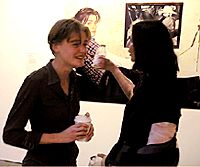
Risk Hazekamp and Janet
Biggs
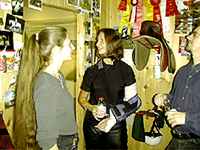
Rachel Berwick with Janet Biggs and her Husband
Bob
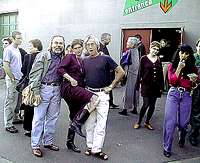
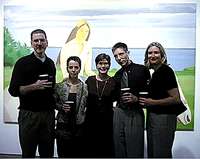
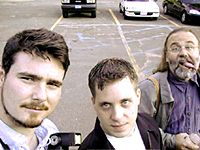
John Groo, Brandon Walsh & Stephen
Hanyes
|
|
[ horsePLAY
]
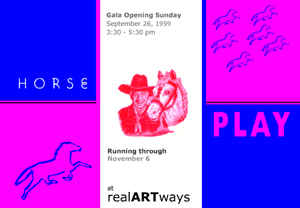
horsePLAY
September 26 to
November 13 1999
Gala Opening
Sunday, September 26 3:30 -
5:30 pm
Live Music by the O-Tones!
Reviews: � �More to be added soon.
Horseing Around At Real Art Ways
By MATTHEW DAMSKER Special to the
Courant
Yeah, yeah, we know: A horse is a horse, of
course, of course. A rose is a rose is a rose. And sometimes a cigar
is just a cigar. In other words, things are often no more, and often
less, than they seem. Happily, that's not the case With "horsePLAY,"
the latest exhibition at - Hartford's Real Art Ways, which proceeds
from a seemingly whimsical premise - gathering art keyed to the
equine - and manages to make something bigger and better out of the
whole multimedia mishmash.
The focus on horse imagery by a
wide range of edgy contemporary artists quickly points us toward
issues of power, obsession and sexuality, but never strays too far
from the realm of human self-amusement.
Consider the video
installation by Lucy Gunning, who offers a sequence of grown women
who have a remarkable flair for imitating horses' snorts, whinnies,
gallopings and prancings about. The result is a compelling
meditation on the way a schoolgirl might assume genderless power via
the equine, but it's also a celebration of sheer horsey love.
Likewise, Mike Ballou's collaged horse toys - small objects mutated
from various toy horse parts - are winsome and obsessive, slapdash
and totemic at the same time.
Then there's Patty Cronin's
walkthrough "Tack Room," with its deceptively typical barnyard
collection of bridles, saddles and equine accoutrements. On closer
inspection, it becomes a shrine to horsedom that suggests a certain
pornography, with its pasted up covers of "Stud" and other equine
magazines that rub our noses in the scent and substance of animal
sexuality. Cronin's other contribution, a series of oval horse
portraits on homey wallpaper, mixes light postmodern irony with
equine iconography.
Janet Biggs goes further, conceptually,
with a video installation that features galloping horses on two
walls and the video image of a seated woman on the wall between.
Entitled "BuSpar" - the brand name of an anti-anxiety drug
prescribed for both horses and people - the piece mixes the static
and active with disturbing power, evoking tightly wound human
anxiety and animal release, bringing together inchoate feelings with
a matterof-factness that is truly surreal, Biggs' other piece, a
large photograph of a young equestrienne in her roomful of prize
ribbons and regalia, is at once cool and highly charged.
Less charged, perhaps, are the images that use horses as
props more so than integral metaphors. A painting by Alex Katz,
"Jean on Horse," is a typically bland-pop contemplation of Long
Island gentry. And Rich McLean's photo-realistic horse painting,
"Lynne's Brymar Shanty Town," is ultimately about sheer visual
information.
More pointed are Richard Prince's appropriated
Western paintings that utilize Marlboro man imagery, while
Scandinavian artist and self-portraitist Risk Hazekamp appropriates
Prince's appropriations, imposing the icy glamour of her own
cowgirl-styled and nude presence to turn Western motifs into satiric
suggestions of desire and detachment.
There's even a brace
of paintings by Mark Wallinger, one of the hot YBAs, or Young
British Artists, now making waves at the controversial "Sensation'
show at the Brooklyn Museum of Art. Wallinger's "Sir Raymond Brown"
and "Lady Brown" are identical paintings of empty jockey uniforms,
cleverly emphasizing the classism of British culture. Even more
playful is Jason Rhoades' "steer" for roping - a contraption that
features steer horns mounted on a motor scooter
Ride 'em
cowboy, indeed. Sue Williams's sketchy paintings of splayed horse
limbs; and hindquarters reek of sexual obsessiveness, while the
capstone of the show may well be the small drawing by Paul Cadmus -
a homoerotic image of young men toweling off that has nothing equine
about it other than its title, "Horseplay."

New Art Examiner
by DAVID RAU
It doesn’t take a large animal
veterinarian to asses the virility of horsePLAY, an exhibition
showcasing art inspired by horses. Featuring the work of seventeen
artists, the exhibition does not present the horse as the star of
the show, but rather as a catalyst for an array of work that reveals
the equine’s prevalence in a number of guises, ranging from
luxurious pet and plaything to an American symbol of robust
sexuality.
Although not indigenous to the United States,
several works suggest that the horse has become symbolic of the wild
romantic spirit of America, specifically the American West, due
mainly to the heroic stature appointed to cowboys through classic
Westerns and epic-scale cigarette advertisements. This provocative
allure of the cowboy spurs an 1997 installation by the Dutch artist
Risk Hazekamp featuring a large color photograph and 93-second video
loop. In the photograph, the recumbent artist is dressed like an
American cowgirl (red-and-white checked shirt, dark blue jeans, and
cowboy boots) and faces an image of a reclining cowboy (seemingly
thrown from a horse), which hangs seductively over her bed. The
cowboy appears to be looking at her, and she in turn is looking over
her shoulder gazing at the viewer, unashamed of their quasi-coital
positions. The voyeuristic element is highlighted in the video which
slowly pans her clothed body.
Another remarkable work is
Patricia Cronin’s “Tack Room” (1998), a convincing presentation of a
horse owner’s privte sanctuary, which engulfs the viewer (and in
this case, the smeller) with the evocative scents of straw, leather,
and fresh lumber. Measuring ten feet by ten feet, the barn-like
space is obsessively, albeit neatly, filled with horse-related --
and somewhat kinky -- gear such as saddles, bridles, riding crops,
blankets, ribbons, and leather boots. Throughout the space there is
a distinct air of female homoeroticism (the wood sign over the door
reads HORSE / LOVER) and the walls are covered with images of
beautiful women and horses carefully clipped from equestrian fashion
magazines. There are also photographs of friends and paintings of
horses. The shelves are crammed with horse grooming products, tonics
and ointments, as well as videos and books featuring horses. Phone
numbers and playful graffiti (“I LUV KATIE”) are scrawled on the
fresh timber lending a keen sense of authenticity.
Both
entertaining and slightly disturbing is Lucy Gunning’s video “The
Horse Impressionists” (1994), a compilation of five women performing
solo renditions of horse sounds, mainly whinnies and snorts, often
accompanied with exacting horse-like movements. The women answered
an advertisement for their talent in the classifieds of the New York
Times. There is a wonderful (and somewhat humorous) tension between
the documentary-style of the recording and somewhat absurd behavior
being genuinely performed. nonetheless, the sheer virtuosity and
child-like glee of the performances reveal the woman’s fervor, and
more likely lifelong obsessions, for horses.
David D. J. Rau
is the Director of Education & Outreach at the Florence Griswold
Museum in Old Lyme, Connecticut. |